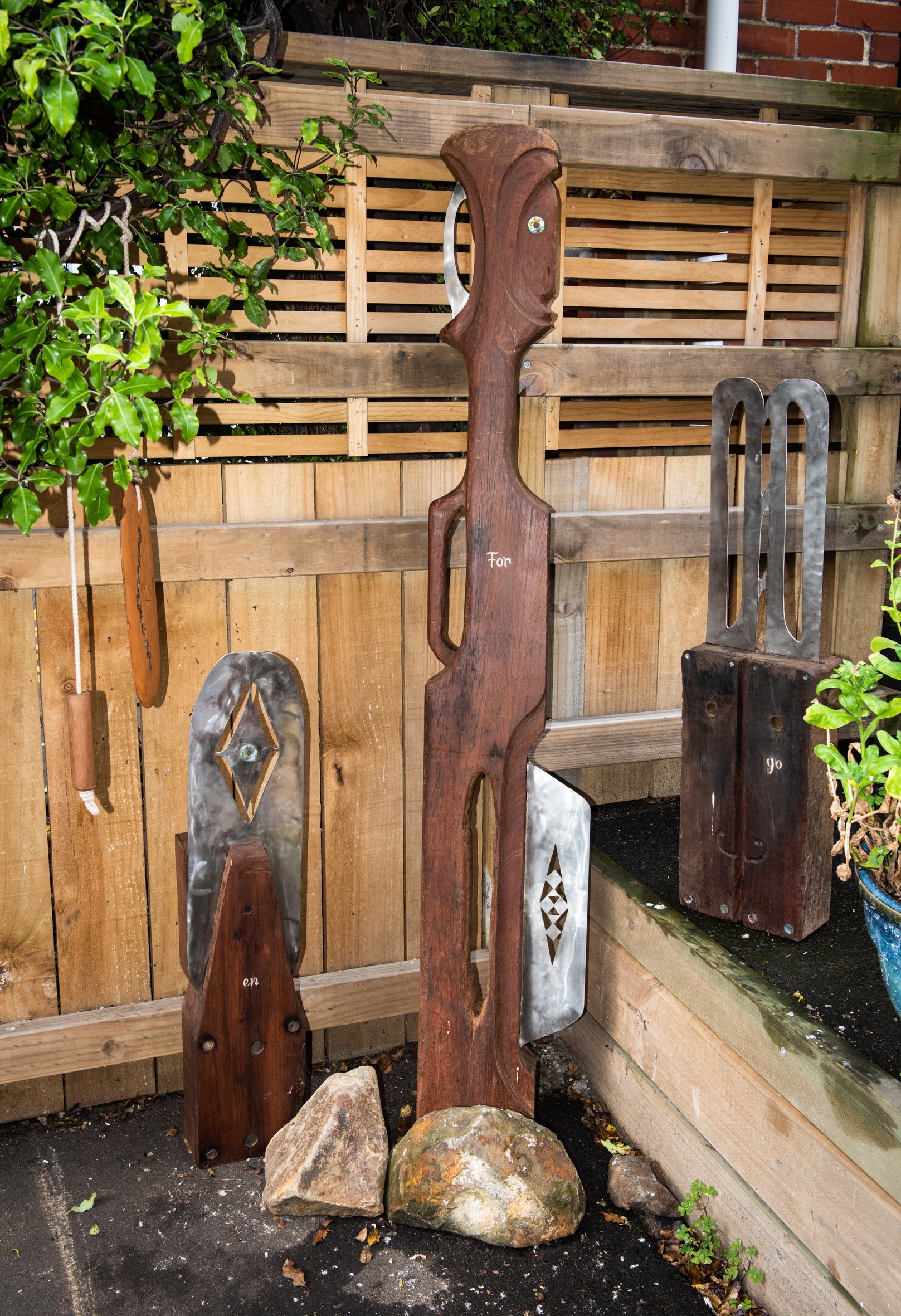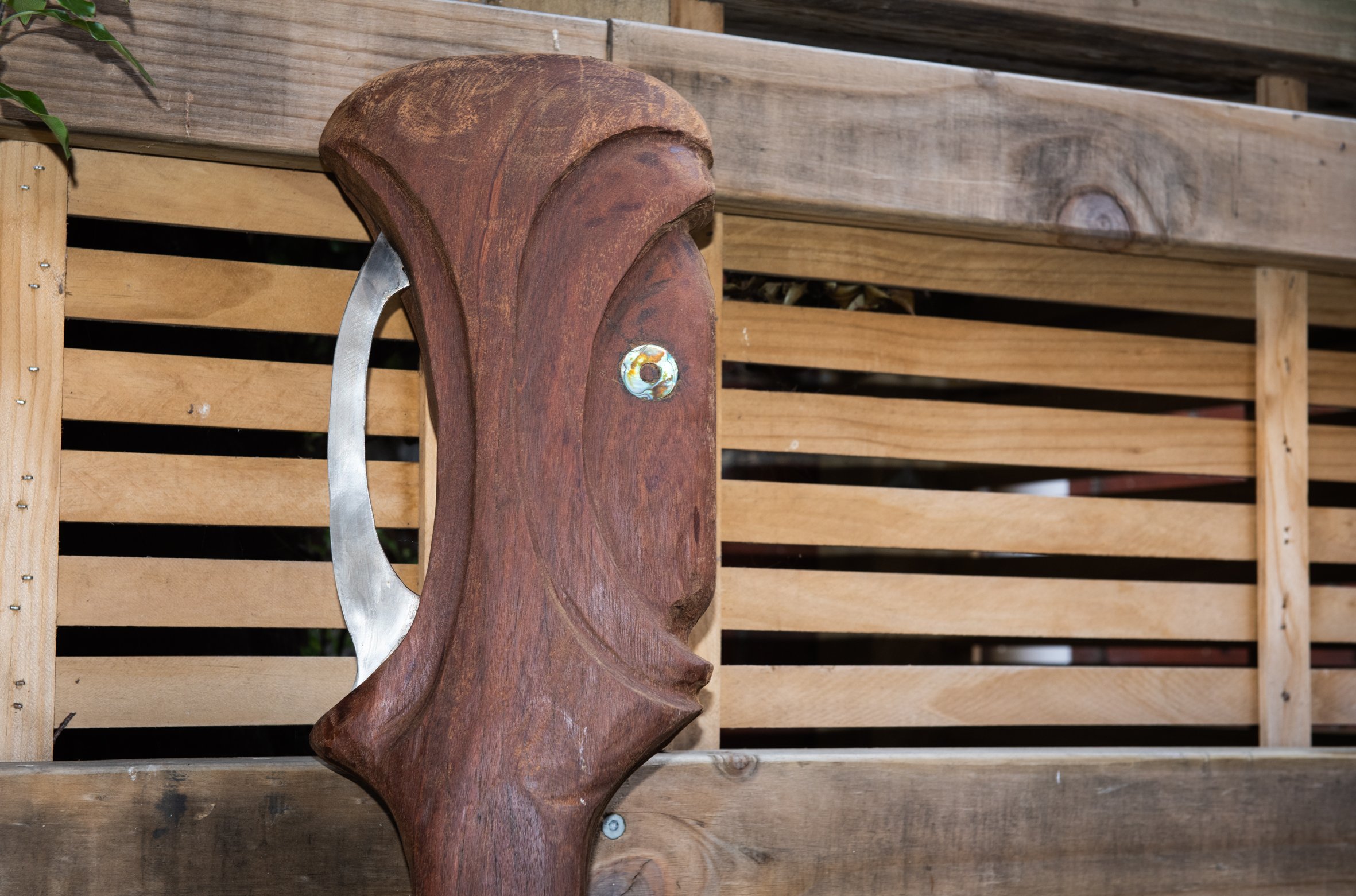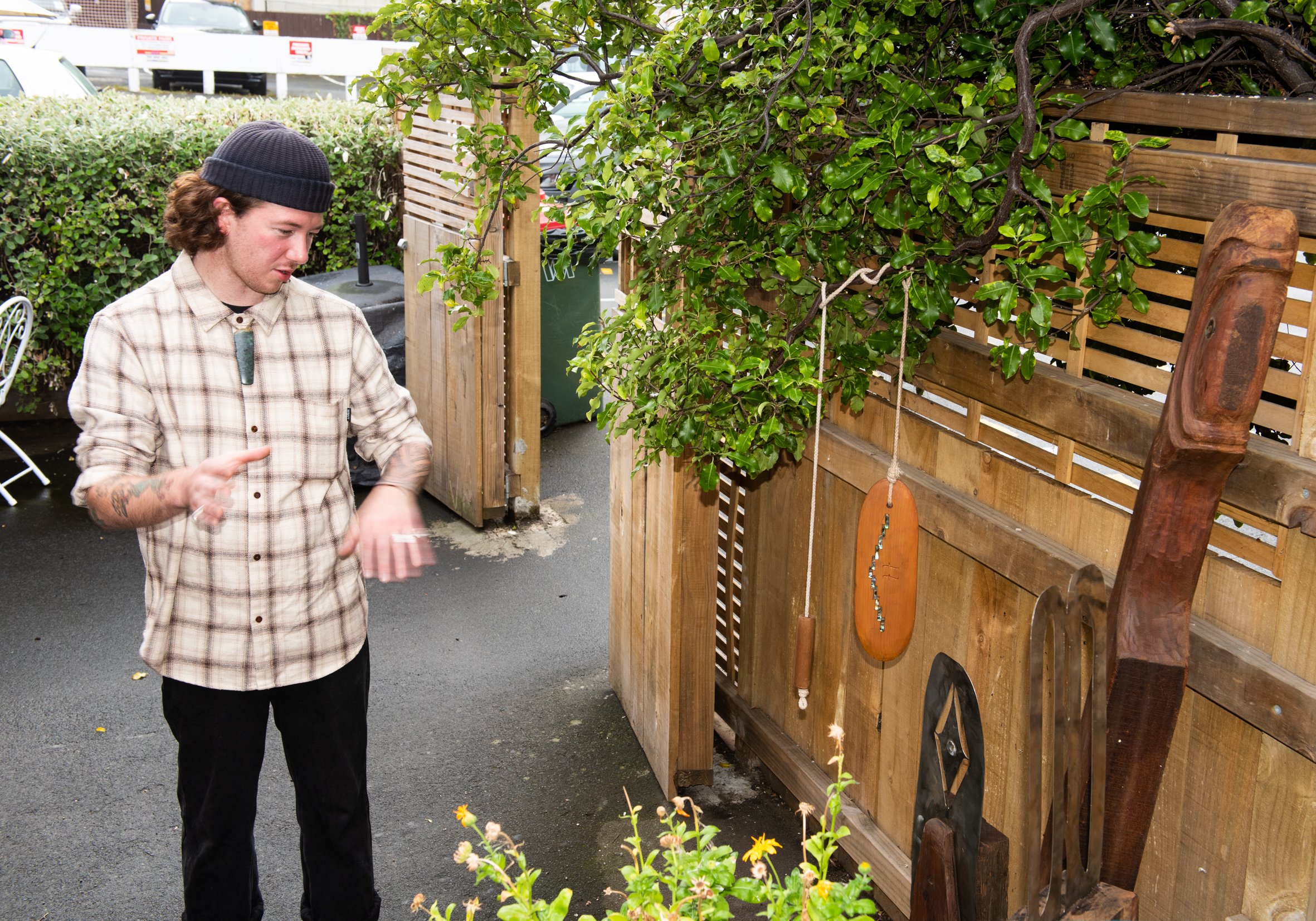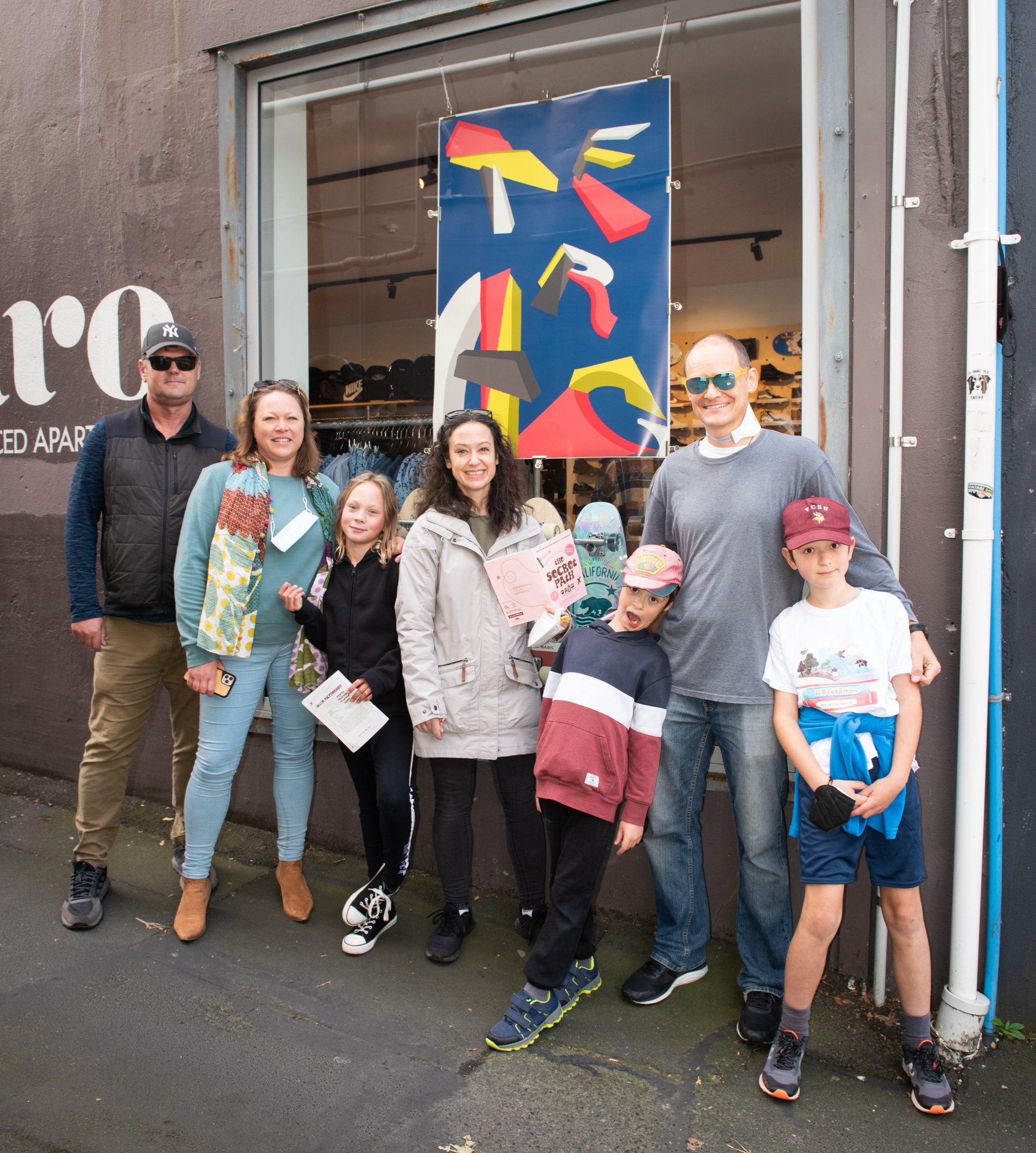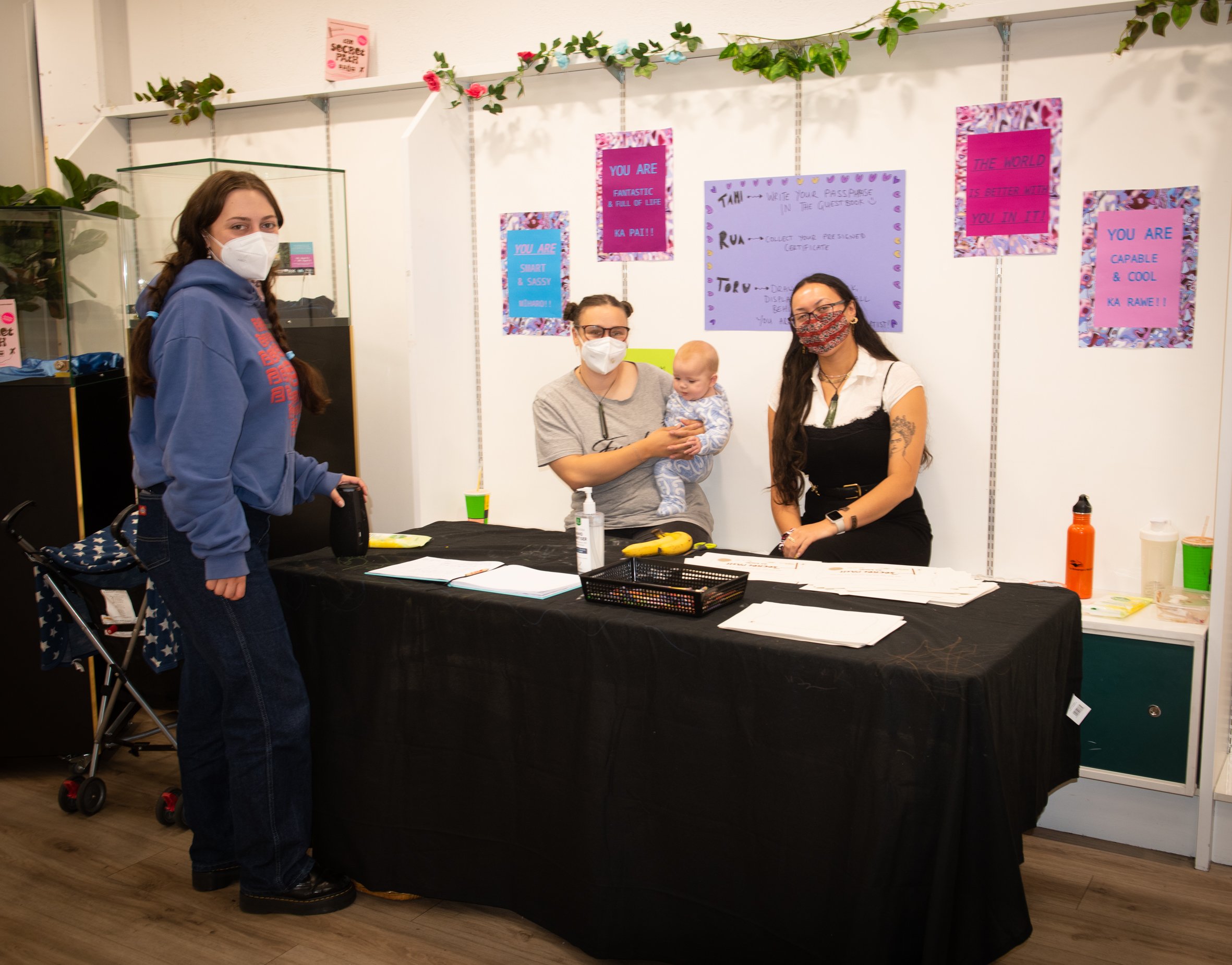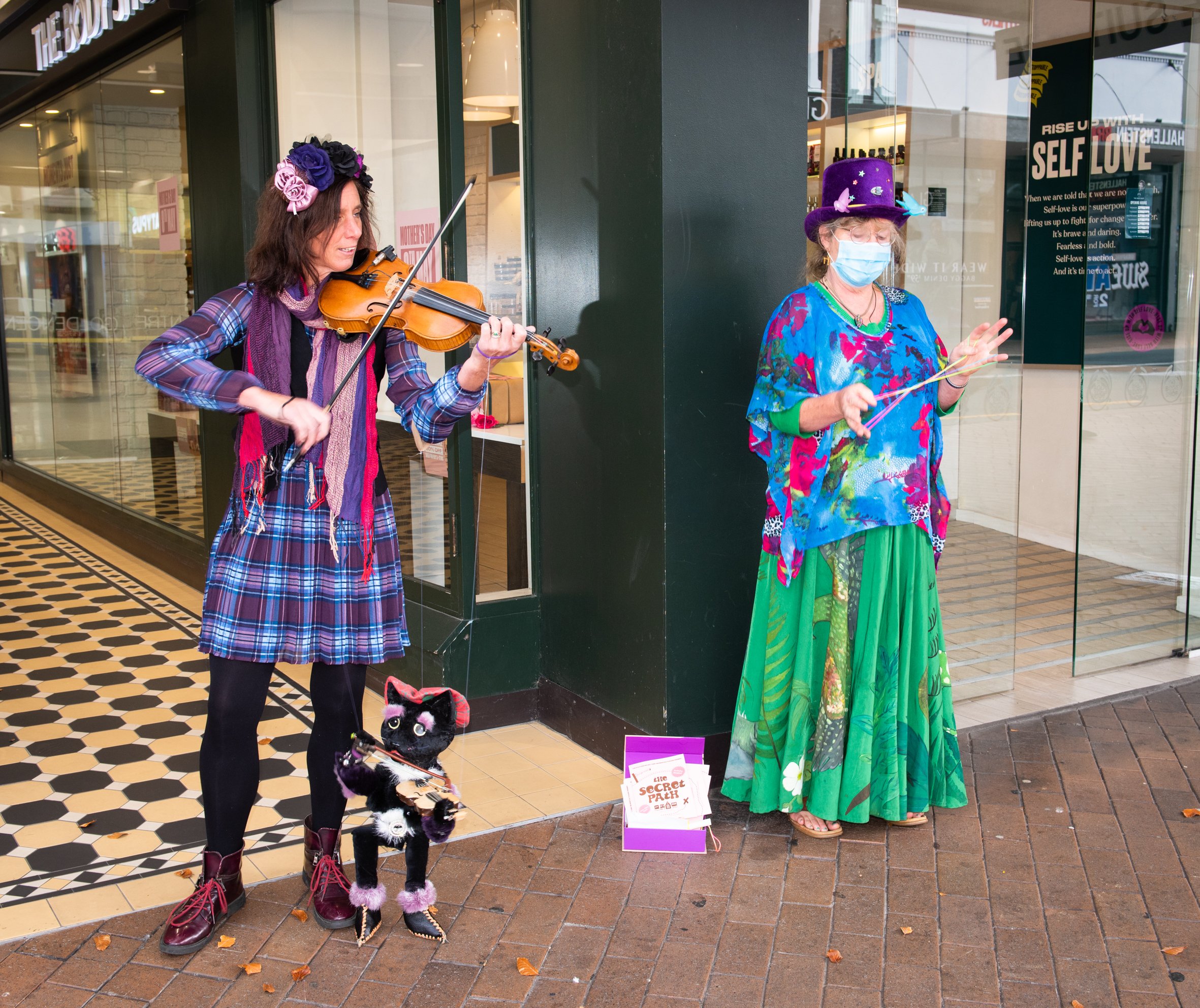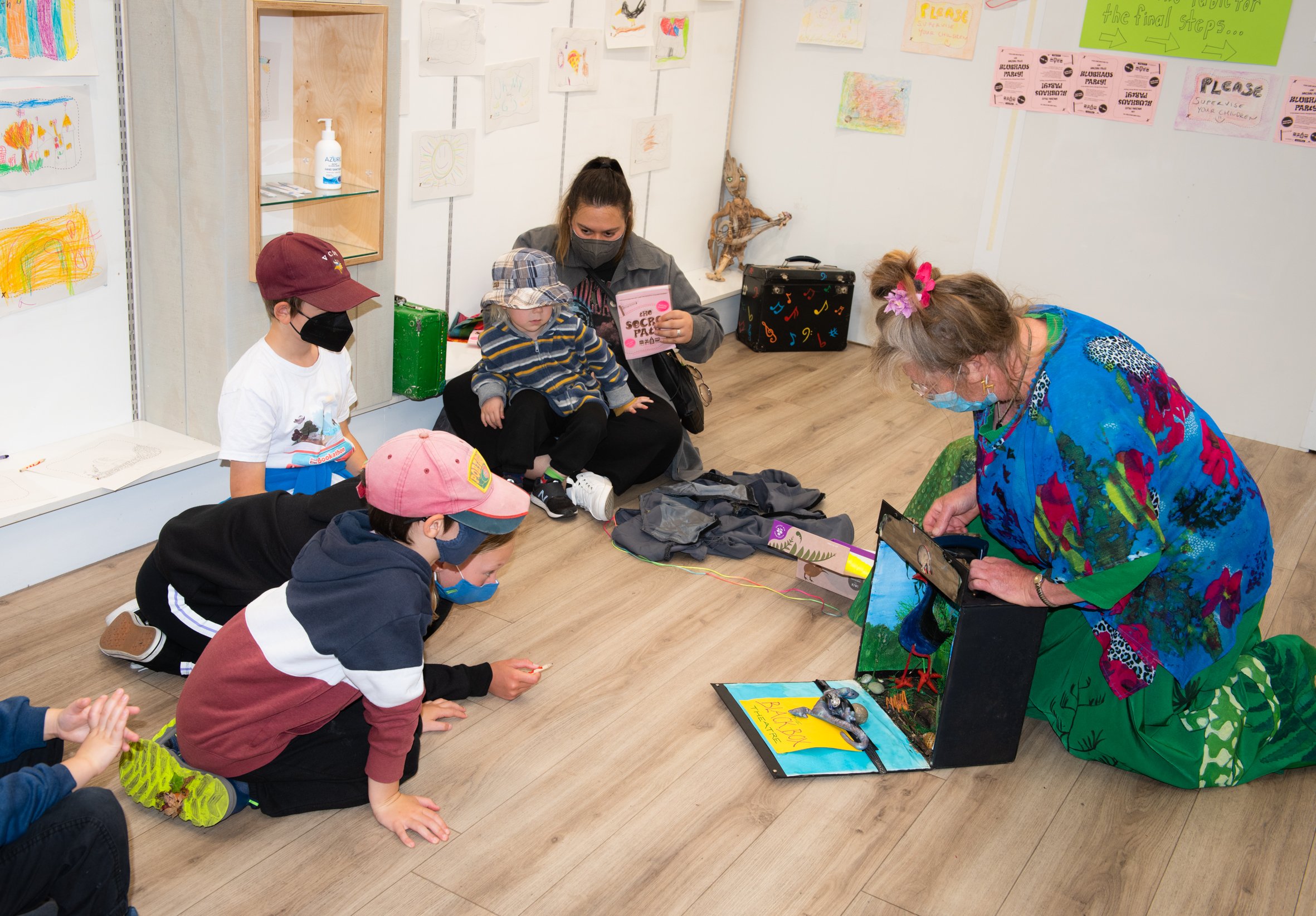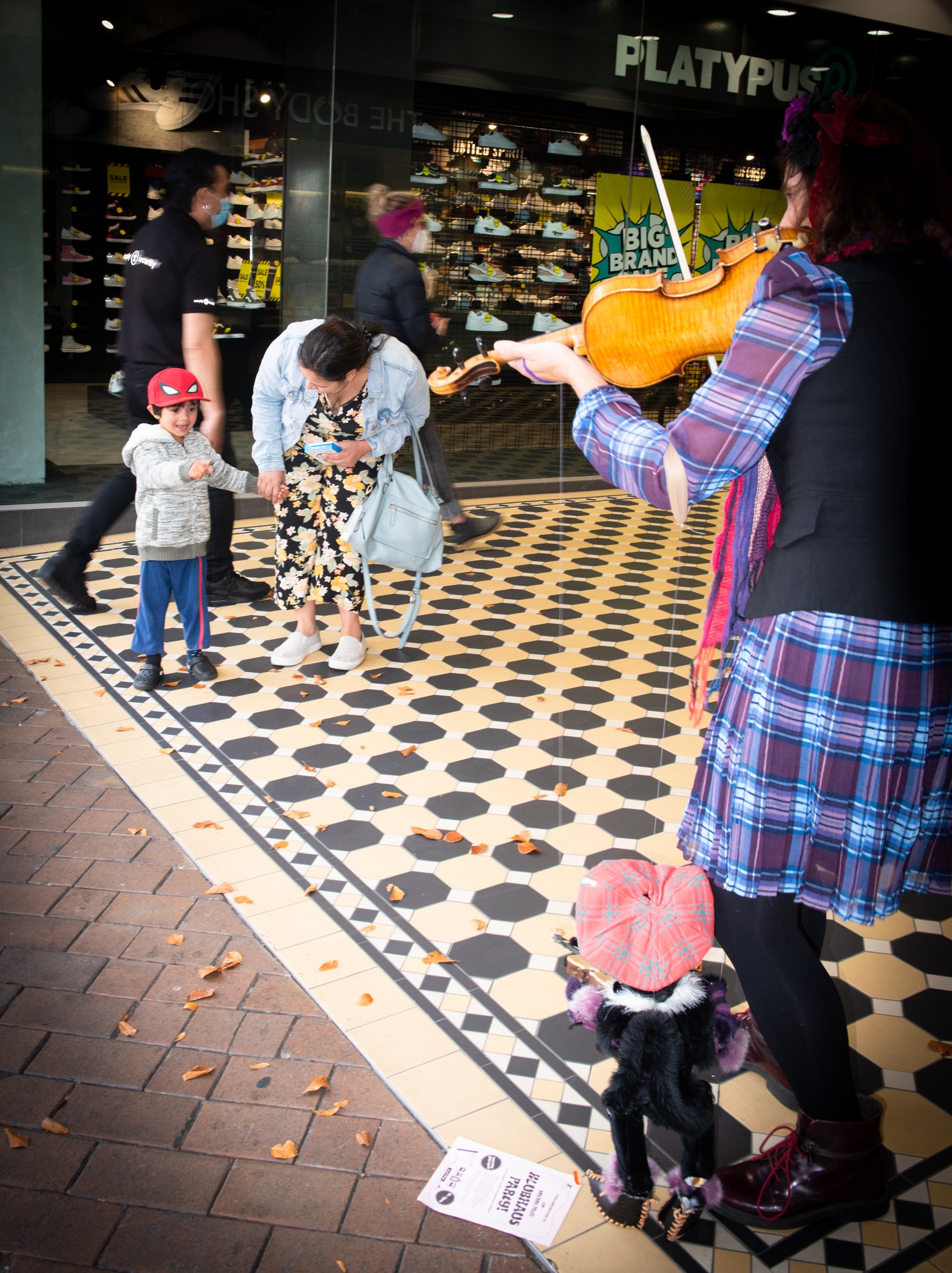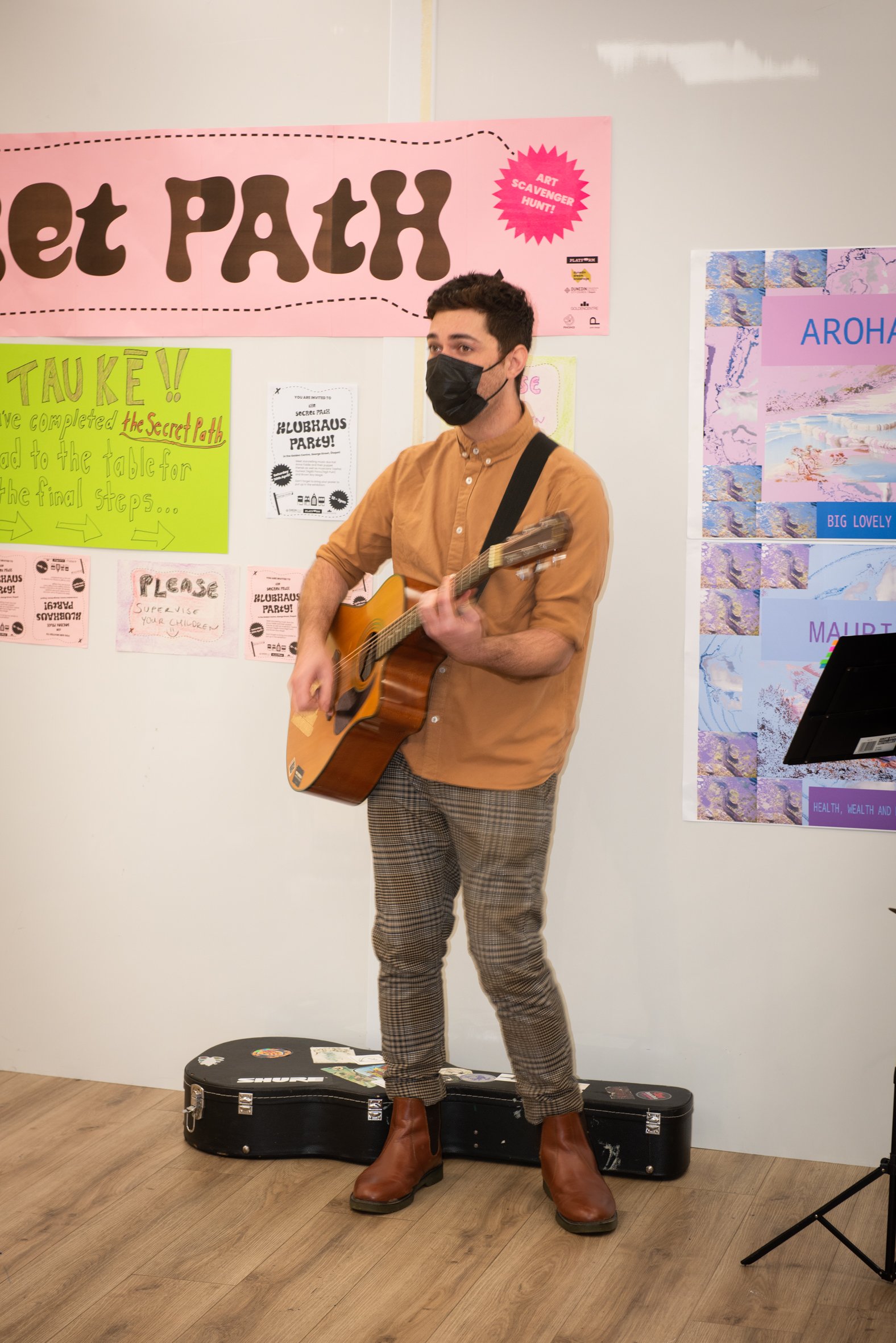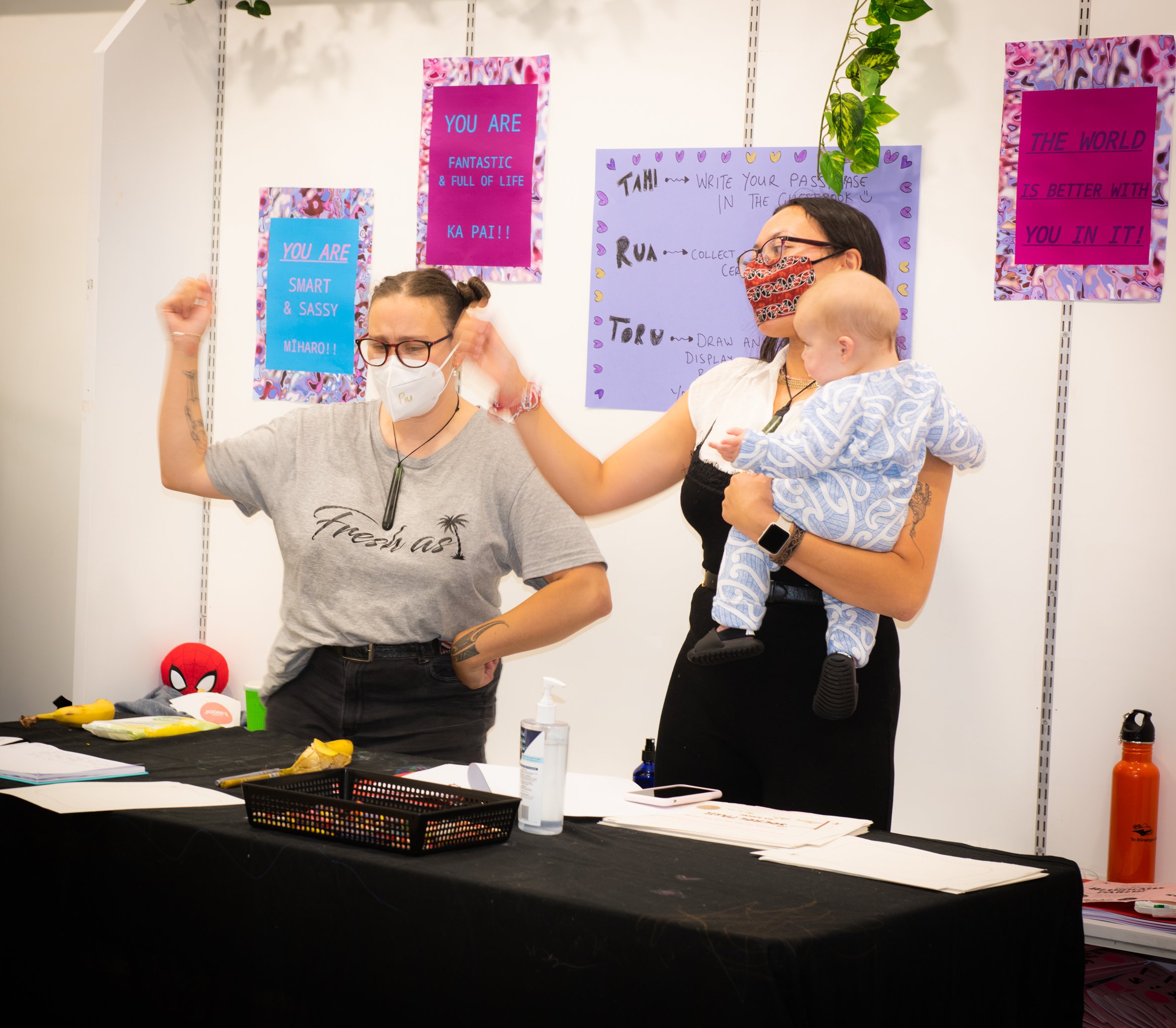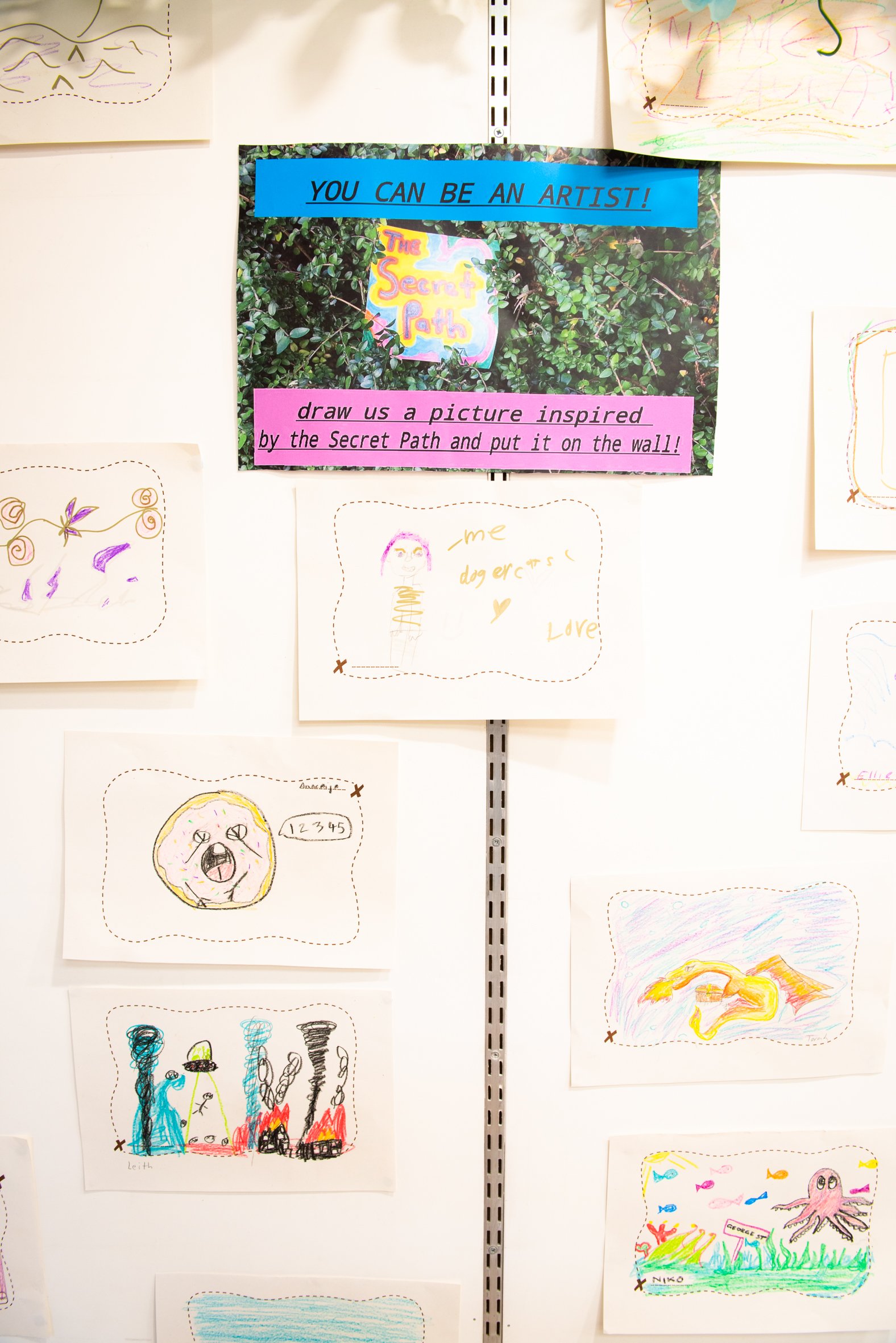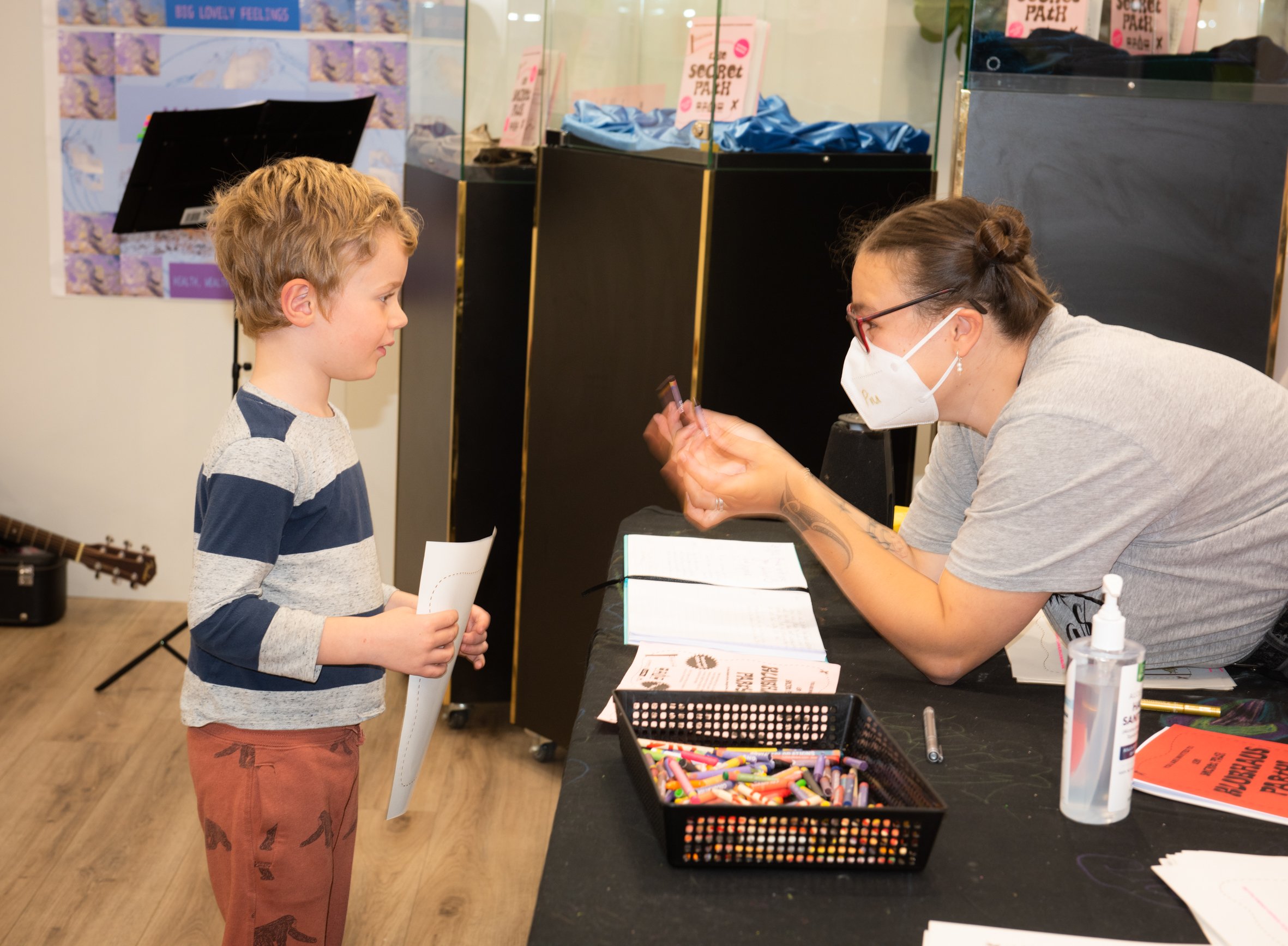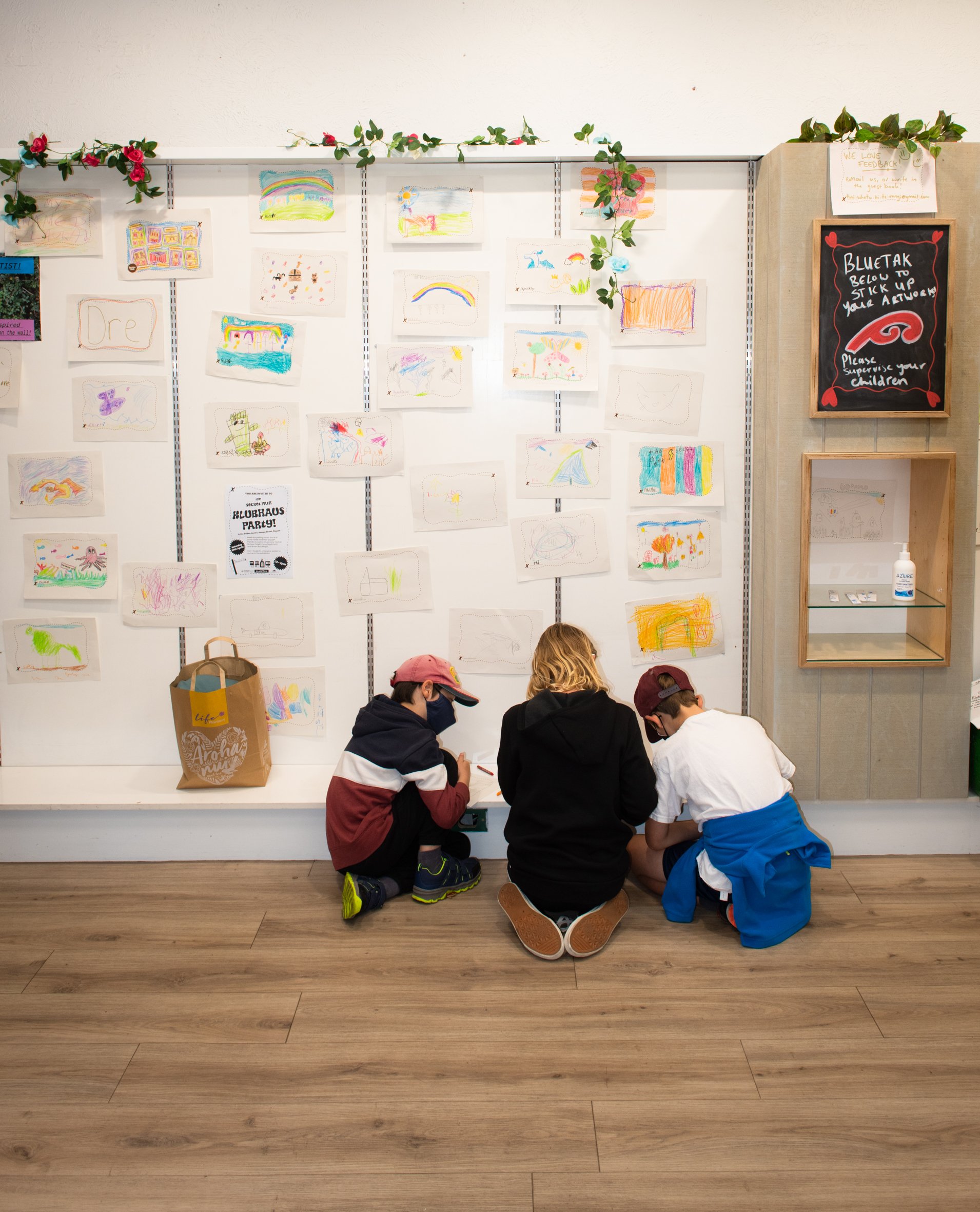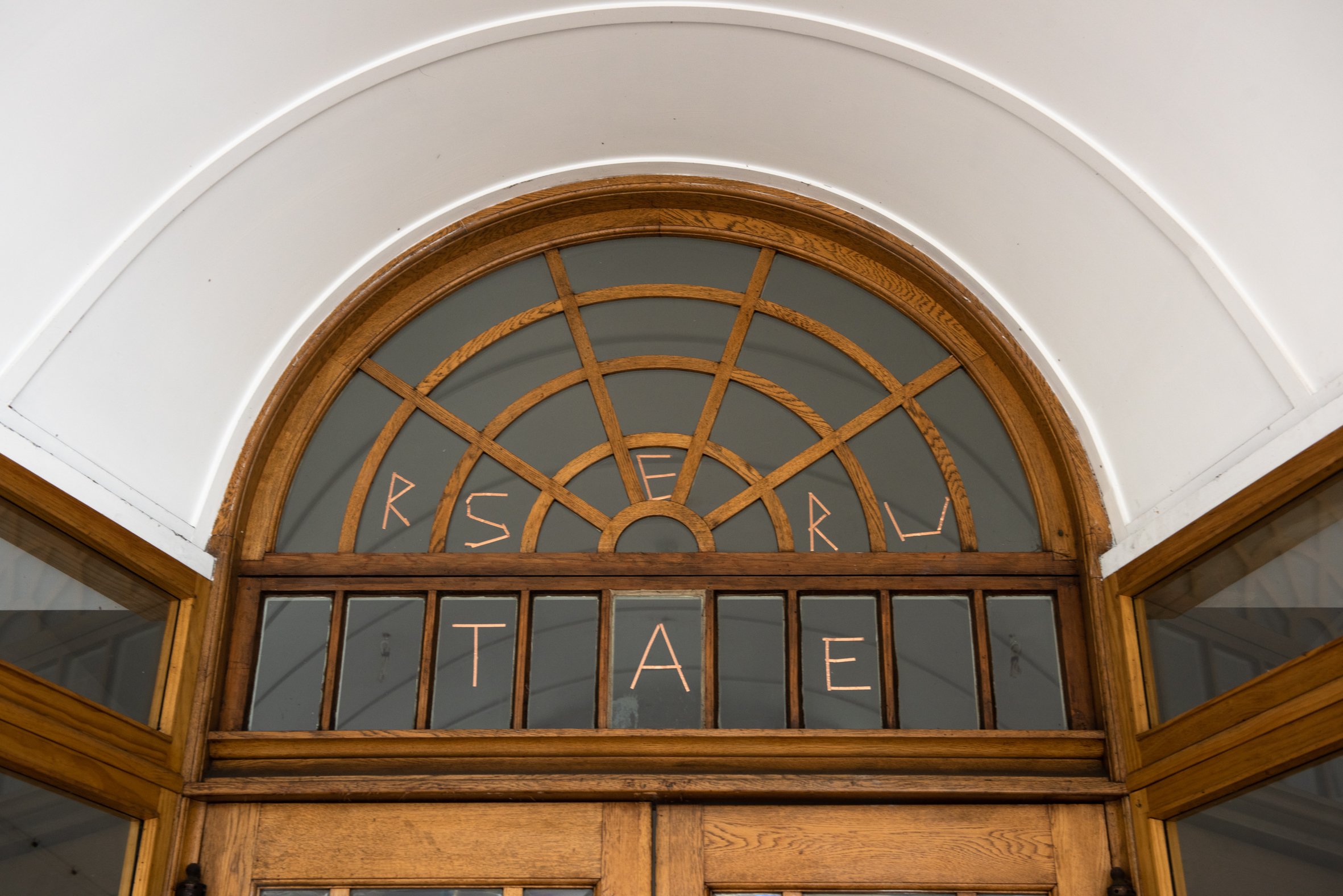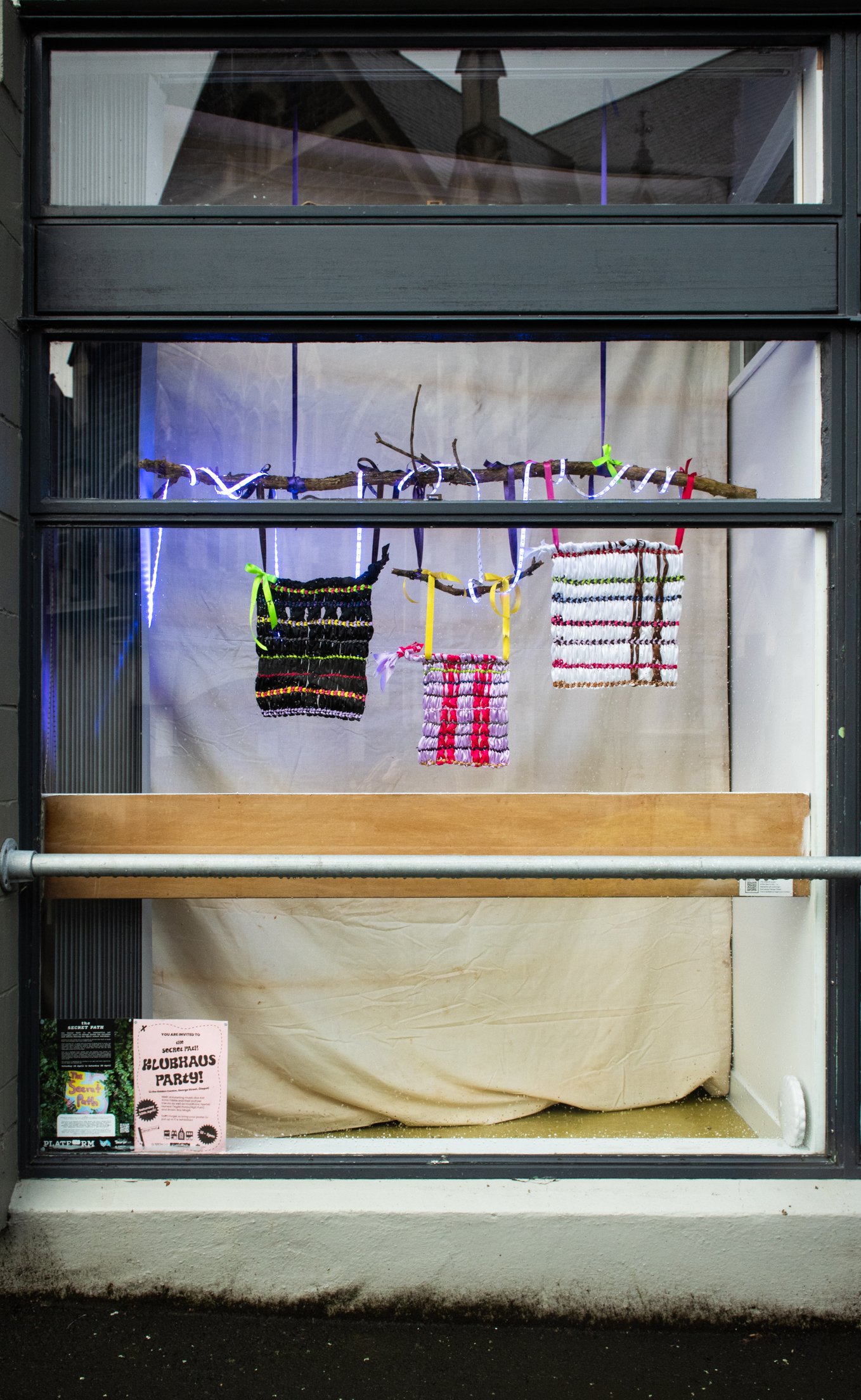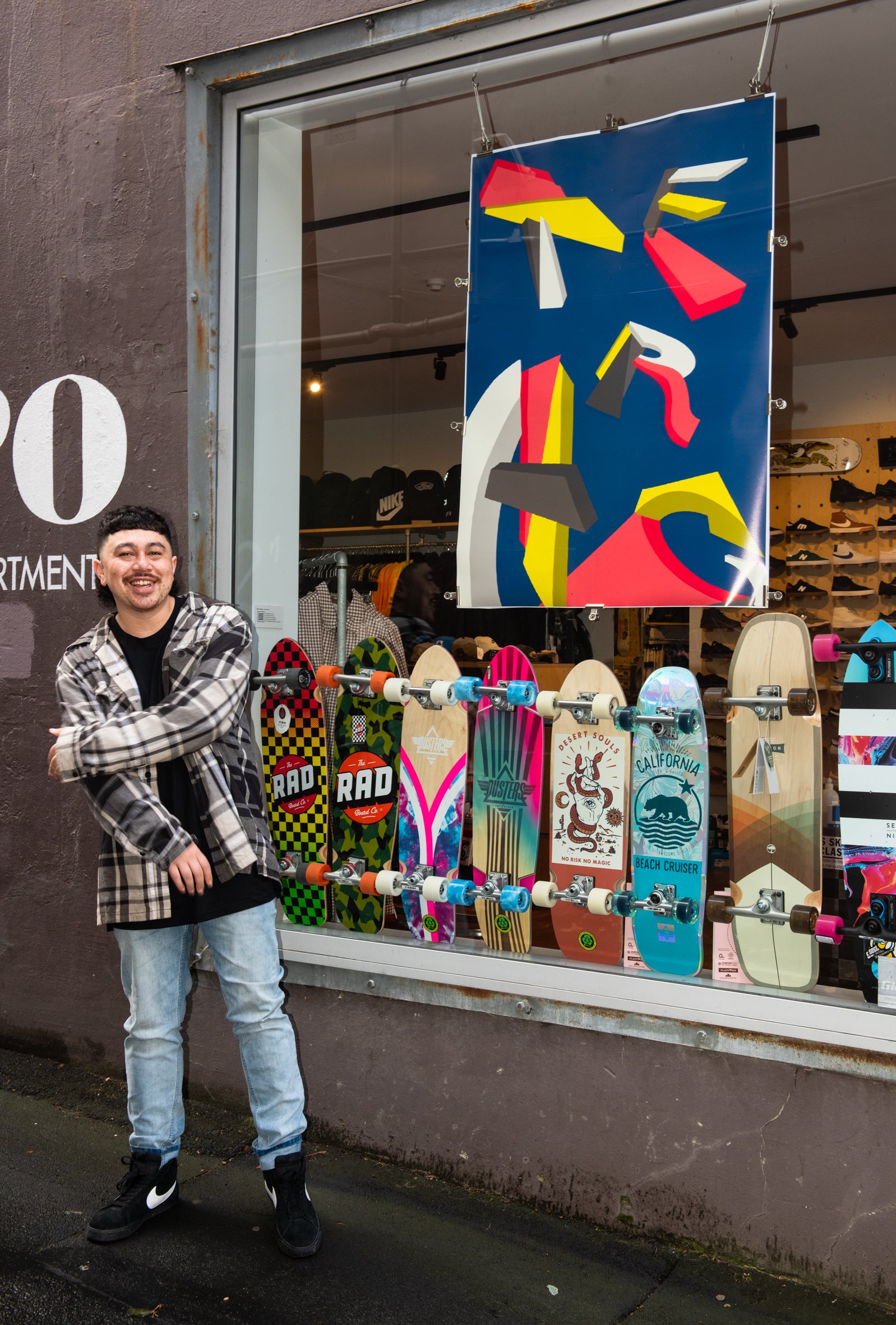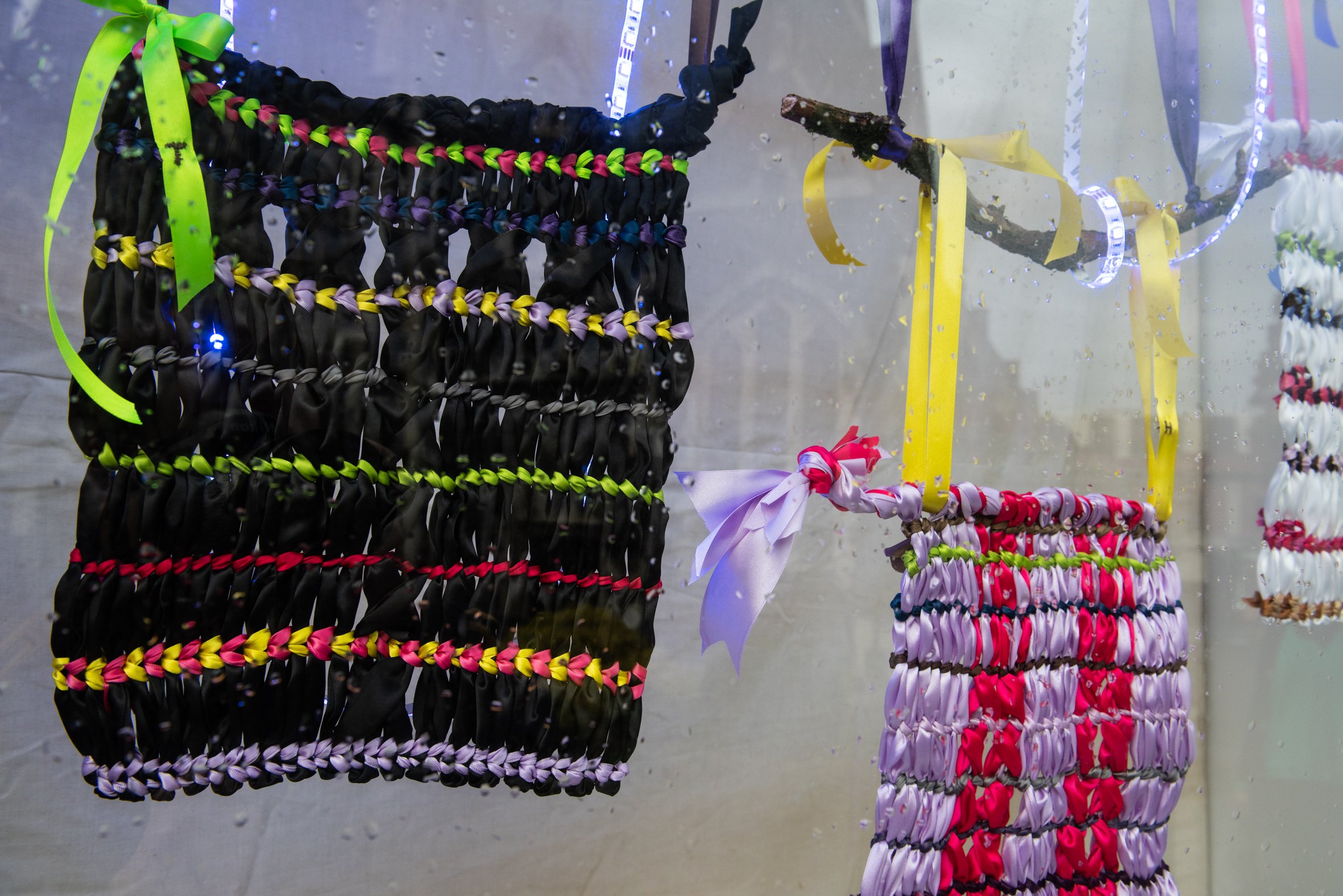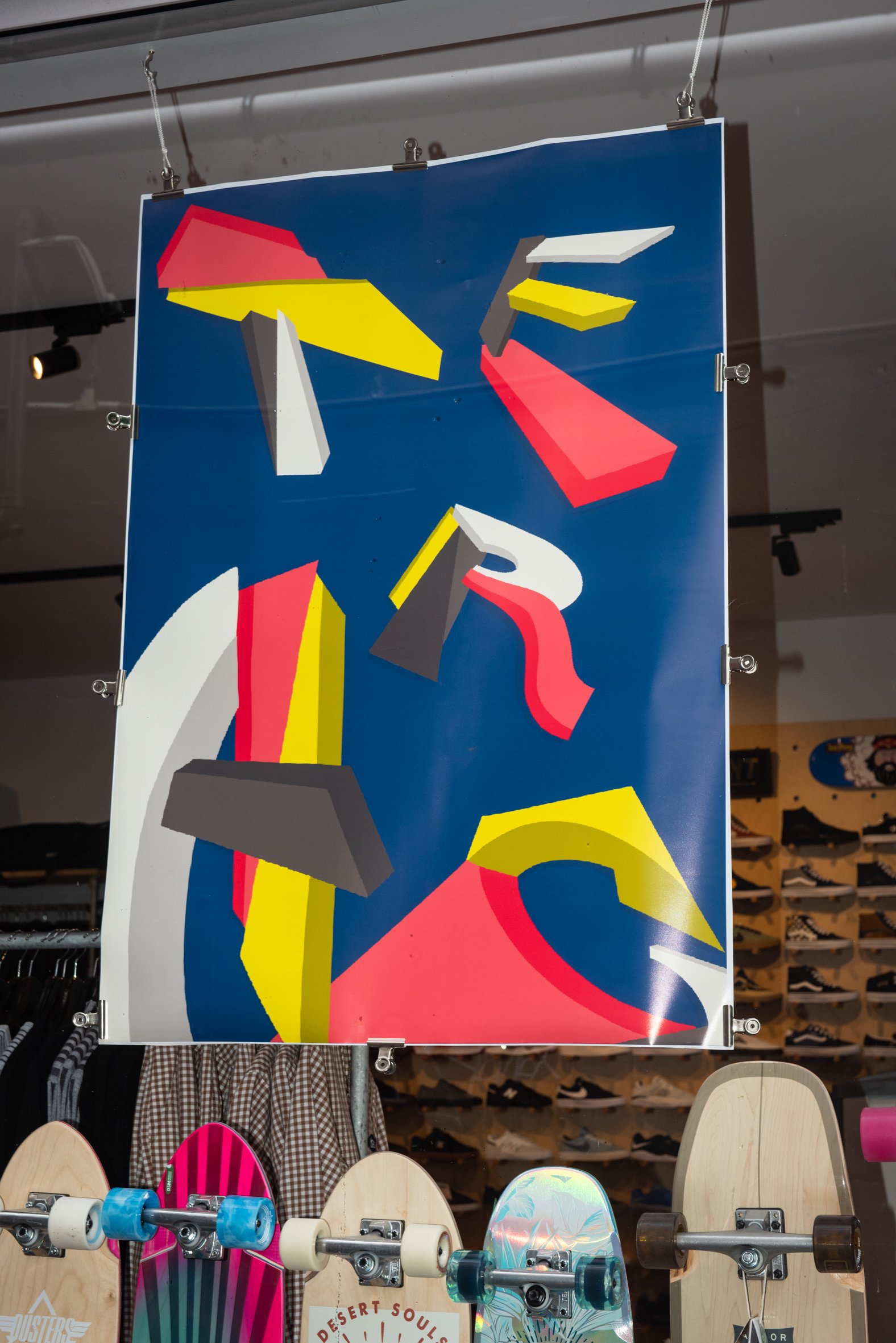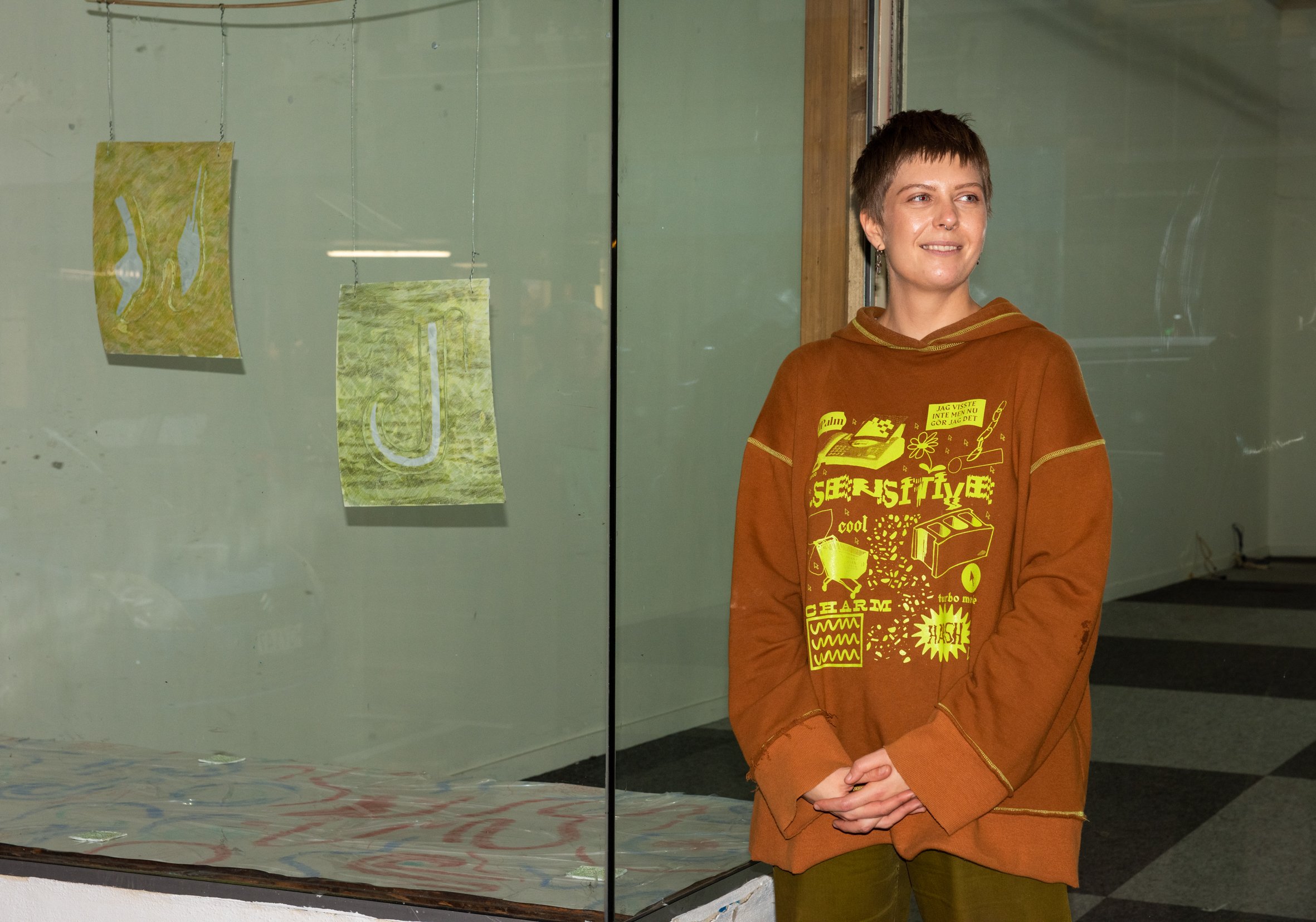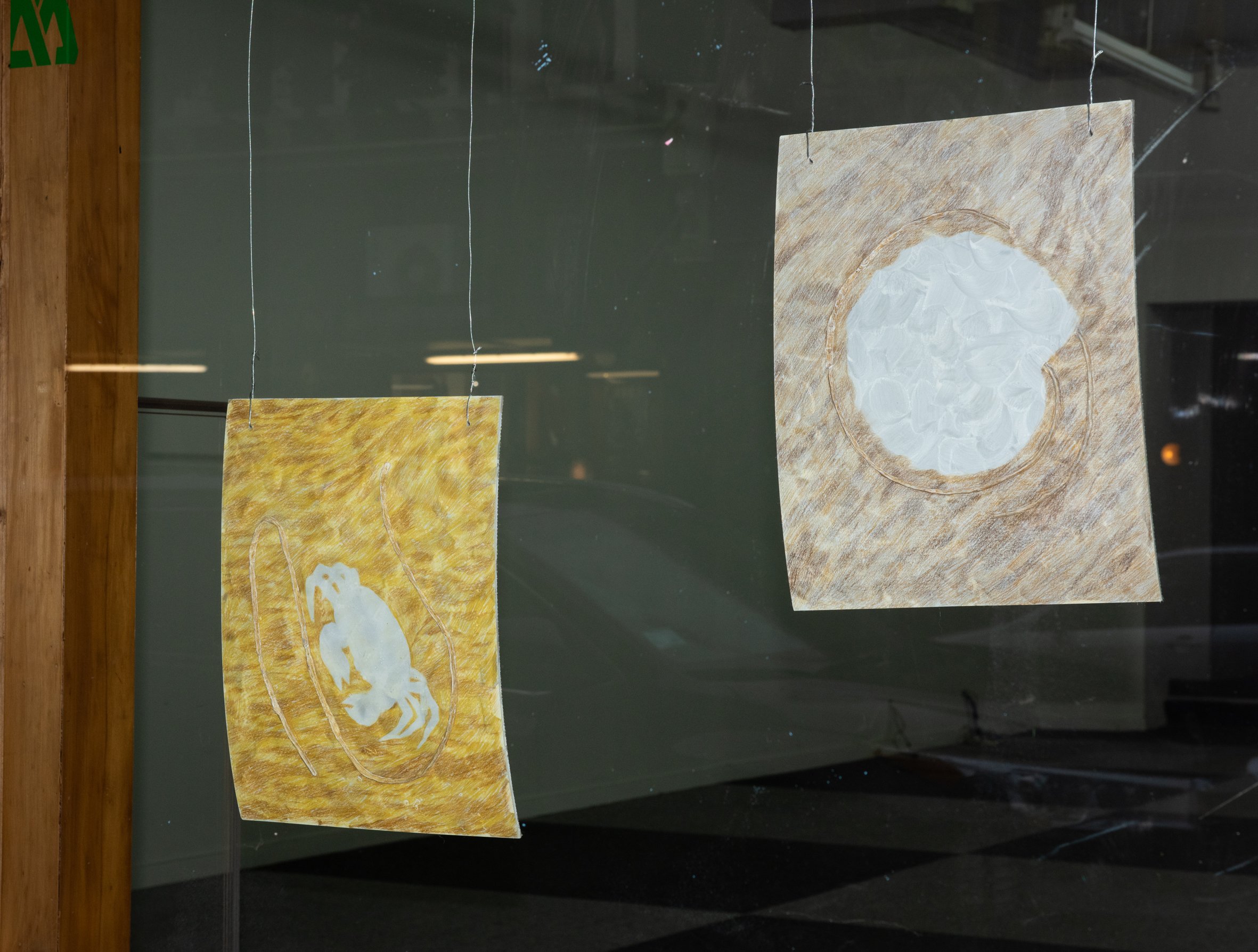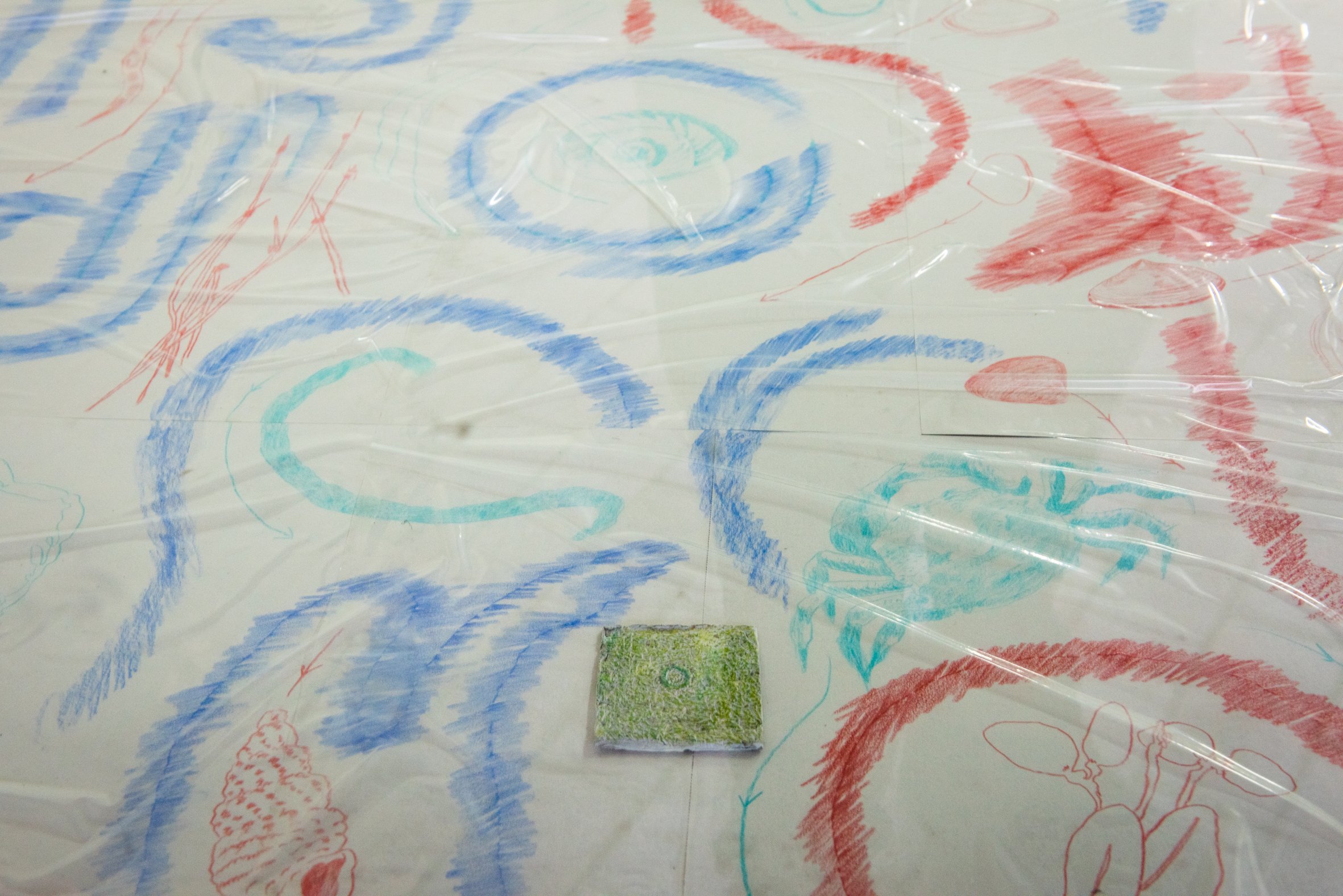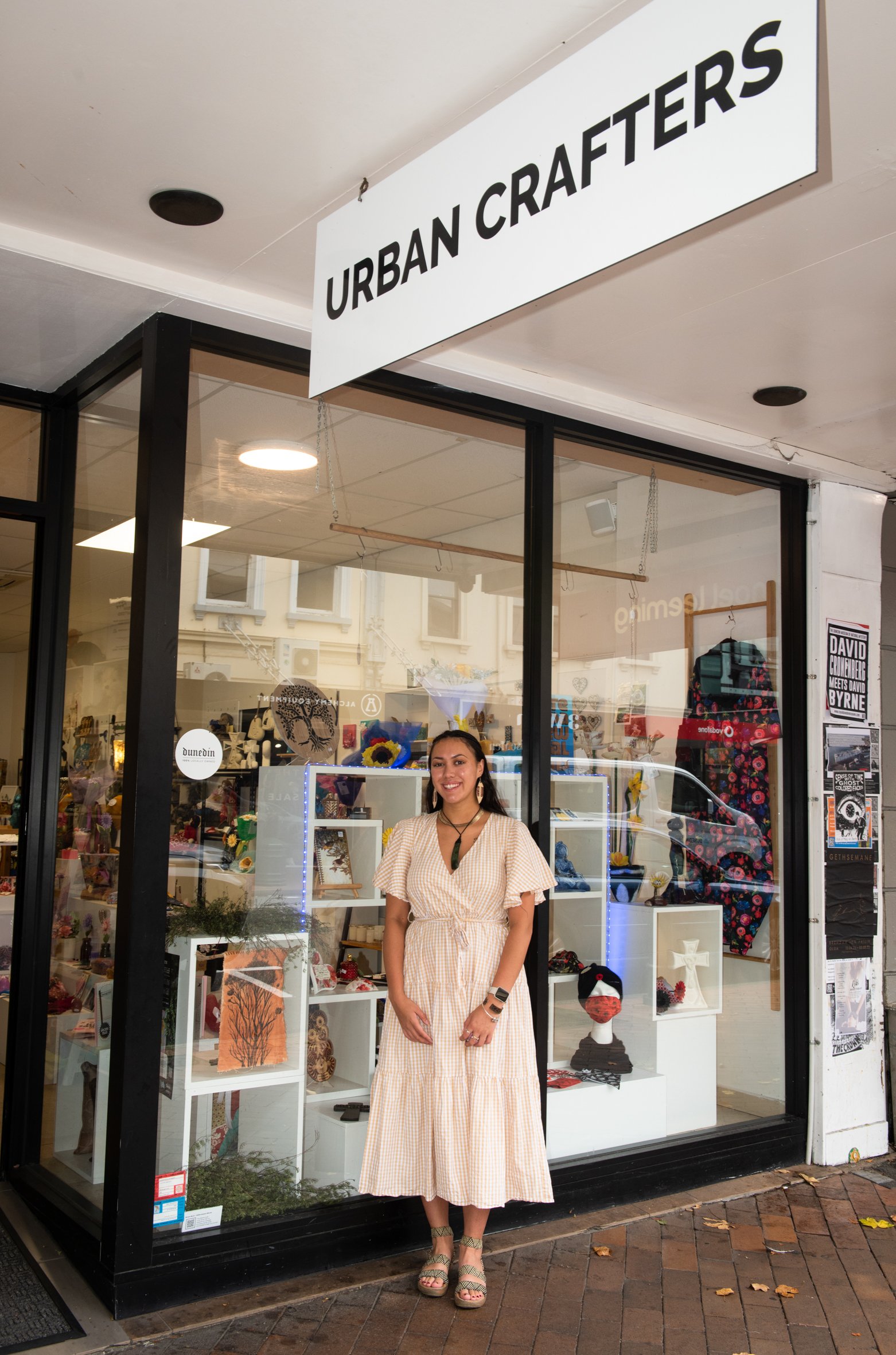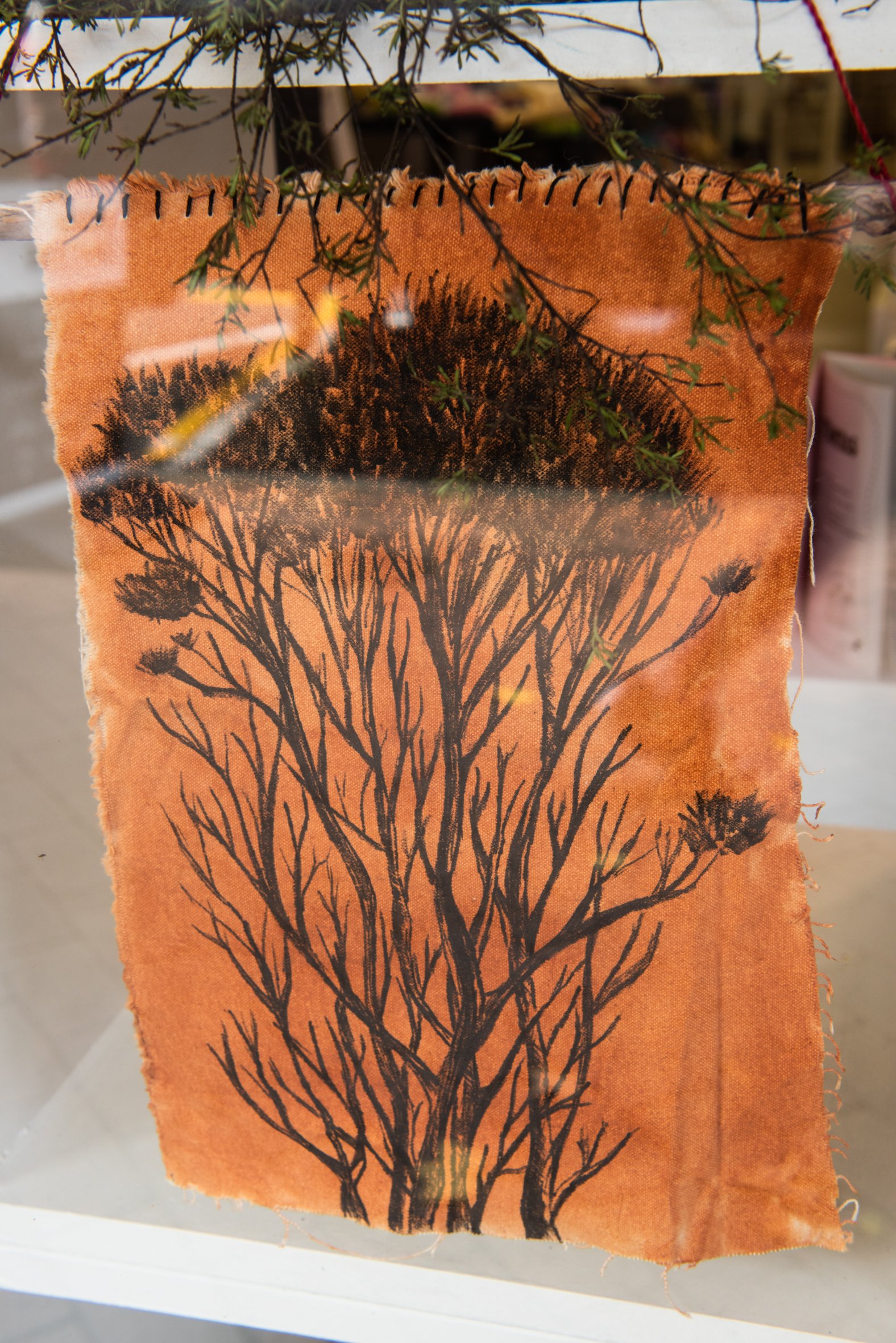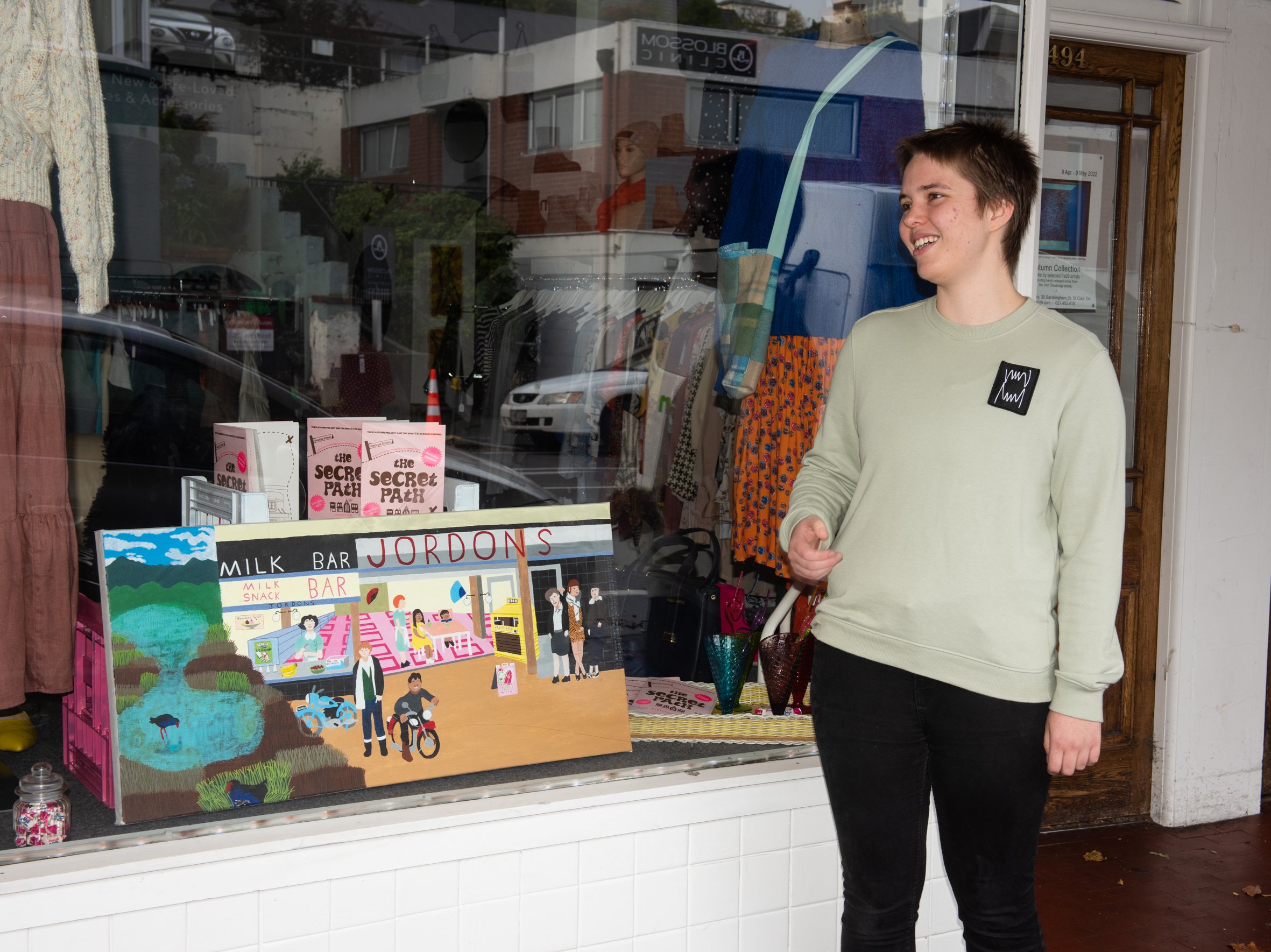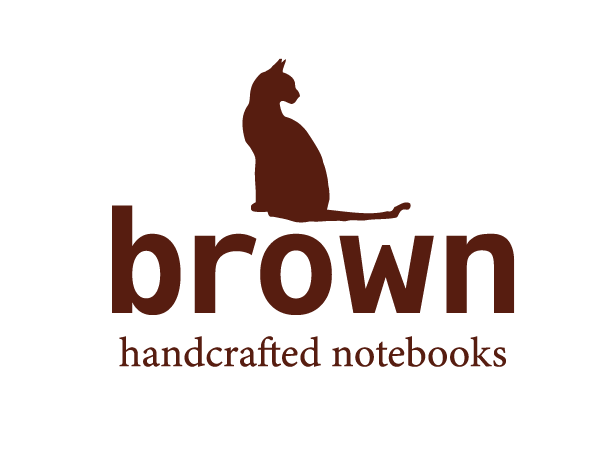Project 62 - The Secret Path (The Platform Project)
the Secret Path
Tini Whetū Playful and light hearted, Tini Whetū wants to explore the possibilities of what Māori curatorial practice can be. Facilitated by Piupiu Maya Turei, Tini Whetū is focused on providing innovative and interesting high quality art experiences.
Madison Kelly (Kāti Mamoe, Kāi Tahu, Pākehā), Moewai Marsh (Kāi Tahu, Ngāti Kahungunu ki te Wairoa), Hemi Hosking (Ngāti Tahinga, Tainui, Awhiro), Ed Ritchie, Aidan Taira Geraghty (Waitaha, Kāti Mamoe, Ngāi Tahu), Ollie McPherson (Ngāti Maniapoto), Mya Morrison-Middleton (Ngāi Tūāhuriri) and Piupiu Maya Turei (Rāngitane, Atihaunui-a-Pāpārangi me Ngāti Kahungunu)
16 April - 30 April 2022
Property Partner: Harada Investments, The Golden Centre, Pavement, RDC Cafe, Urban Crafters, Knox Church and Inside Out.
Images: Murray Eskdale
Seeing the Future-in-the-past tense: A reflection on the Secret Path
Stacey Kokaua reflects on the simultaneous past-present-future of Dunedin while on an interactive art scavenger hunt: the Secret Path
Raising children can be quite terrifying these days. In fact, some days you can feel guilty for even bringing them into this mess (I was going to elaborate here but we all know, no need for bleak reminders). This means that the moments of whimsy and magic and wonder take on special significance. During the April school holidays, we got a good dose of all those things when me and my two kids did the Secret Path.
the Secret Path was an interactive art scavenger hunt for children and adults that took place in selected shop fronts along George Street. It was one of those Dunedin afternoons in autumn, with that pale, clear light and a breeze that has people commenting, “It’s warm, isn’t it?”. Me and my kids went to the library, picked up our little pink Secret Path book and set off on our way.
The first page of the Secret Path booklet told us ‘how to play’: follow the map to find each artwork and examine the artwork carefully to find the code word hidden inside. This was accompanied with a map of George Street marked with Xs. We wandered along to our first spot: an art installation in a former haberdashery shop front. I love the word ‘haberdashery’ and associate it with a time when you went to a butcher and a vege market rather than a one-stop duolopy-owned supermarket. The entrance had the name of the old business owner, Dreaver. Does anyone take ownership of a building/business and put their name in a tiled mosaic at the entrance anymore? Because they should. The booklet told us about Elizabeth Dreaver, a businesswoman, now a permanent fixture of Dunedin’s cityscape, her name immortalised in tiles, even if she is no longer a haberdasher.
The artwork on the Secret Path was created by seven artists based in Ōtepoti and looked at the histories woven within the street we roamed along. They were compelling in themselves and you can read more about them here[i]. the Secret Path origins are quite peculiar as it is tied to the Dunedin retail sector upgrade. Retail. Sector. Upgrade. Three words that feel disconnected with art, wonder or a children's art scavenger hunt. The image it brings to my mind is a man in a shirt and tie at a white desk, frowning at a computer screen, periodically clicking a mouse. Click, shuffle, click, click. An air conditioner hums in the background. But someone clever at DCC considered it might be interesting to engage artists in the process of upgrading George Street. They selected the Platform Project (a Dunedin Dream Brokerage initiative) as a way to facilitate that vision. The Platform Project then brought on Tini Whetū and its curators, Piupiu Maya Turei and Mya Morrison-Middleton, to come up with a concept.
the Secret Path was born.
It’s not often I write something that makes me consider infrastructure development. This was almost the first sentence of this reflection but then I reconsidered. But it’s a true statement and one that occurred to me as me and the boys skirted along the roadworks on George Street, past a sign that said, ‘Totally Georgeous!’ and diggers and people in hi-vis vests and boots, drilling away at the street. Dunedin people have voiced scepticism about the redevelopment of George Street. When I looked it up there was a lot of reference to dots (otherwise known as ‘Dunedin’s controversial road dots’[ii]).
I personally find it easy to dismiss these types of discussions. Just let the DCC do its thing, sometimes they’ll miss the mark but generally, we live in a nice wee city with some nice stuff (public spaces, library, functioning infrastructure). But reading between the lines of the people who berate the DCC, there are some well-founded concerns. There’s the cost of the upgrade as we see a rise in the cost of living in other areas, everywhere. But there’s also another question when it comes to upgrades and developments: what are we losing?
Dunedin has retained much of its historical architecture in comparison to other cities in Aotearoa. This is connected to money made during the Otago goldrush and the relative economic stagnation in the 20th century.[iii] And in those autumn afternoons, the Edwardian and Victorian buildings are framed in the best light, bringing out the most flattering tones in the bricks of limestone and basalt, the sun shining low behind eaves and towers. the Secret Path led us to Mya Morrison Middleton’s work in Knox Church. We wandered the grounds as my younger son discovered architectural adornments on steel pipes, stained-glass windows and plaques, fixtures you don’t see in buildings built in the last 50 years. These buildings and the layout of George Street are a legacy and have reminded Dunedin citizens of who they are for generations.
But the Secret Path also drew our attention to the other fixtures of this land that have not been so visible. Six of the seven artists in the Secret Path are Māori, bringing an under-represented perspective on the ‘Edinburgh of the South’. Aidan Taira Geraghty’s work Tangata, kia ua! stationed three pou and a purerehua outside café RdC and included references across time; to music created by Māori over centuries and to hospitality businesses that host music and are currently impacted by the pandemic.
And even before the arrival of tangata whenua, what was here?, the Secret Path asked. What else do we forget as we walk along George Street on errands or to work? Madison Keely’s work Like the town, I dig and I look and Ollie Mcpherson’s Jordan’s milk bar on George Street reminded us that every day we walk over what was once a wetland. Where does the wet go if it is no longer on the land? How long did it take for the land to adjust to pipes and culverts? Will there come a time when we mourn that we ever tried to rid our land of water? Is the city due for rewilding?
How is the landscape past impacting the city of Ōtepoti now? What is it telling us about the future?
If you google future-in-the-past, you find explanations about the different ways the English language conveys an event in the future described in the past tense. If you are around my age (late 30s), terms like ‘past perfect’ and ‘past progressive’ did not make much of an appearance in your English learning during schooling. I won’t unpack it here. Rather I wish to note that in a space like the internet that is dominated by English speaking nations, the concept of ‘future as past’ is dominated by tutorials around the rules of speech. But it’s not much of an intellectual stretch to see how the past, present and future are inter-woven. Landscapes tell us this. The stories of cities remind us.
There is the whakatauki: Kia whakatōmuri te haere whakamua | I walk backwards into the future with my eyes fixed on my past.[iv]
The poet Selina Tusitala Marsh also illustrates this interpretation of temporality while asking us to consider how our actions in this time and space impact others.
What we leave behind, matters to those who go before
we face the future with our backs, sailing shore to shore[v]
Future, past, life, change, regeneration, restoration, redevelopment. On and on it goes whether we like it or not.
On a cynical day, I think about that day on the Secret Path and think that it was very shrewd of the group behind Totally Georgeous to enlist a group of artists to help us engage with civil maintenance. But then so are the curators of Tini Whetū. They took up a project that asked to engage with something as seemingly banal as infrastructure and completely hijacked it, injecting the concept with their own kaupapa of art, criticism and whimsy, weaving in the narratives of artists and histories of our city-scape. The theme of a built city landscape is ripped open at the seams, made magical in an exploration of time and human existence on this whenua. While me and my boys were walking up and down George Street on an art treasure hunt mystery tour clutching at our little pink book, it was apparent that there are still temporal tides in constant motion over the city. Where the currents of the past and future constantly clash and fuse, yield and overpower, in a constant cycle of reinvention.
[i] https://vernacular-online.nz/the-secret-path
[iii] http://www.visit-newzealand.co.nz/Dunedin/historic-buildings.html
[iv] See Lesley Rameka’s article https://researchcommons.waikato.ac.nz/handle/10289/11120
[v] See Selina Tusitala Marsh’s poem ‘Unity’ https://poetryarchive.org/poem/unity/
By Stacey Kokaua

